Submitted by chandra on Thu, 2012-10-04 10:36
In writing a press release, a major goal is to present the truth, and nothing but the truth. However, it isn't practical to present the whole truth. For example, the paper associated with our press release last week was only six pages long, but contained 38 references to other papers, and each of these papers contain many more references. This is how research advances, building incrementally on previous work. Since we have limited space in a press release we cannot present the whole truth and we only include the information that we think is crucial for explaining the result and its significance.
Submitted by chandra on Mon, 2012-09-24 11:54
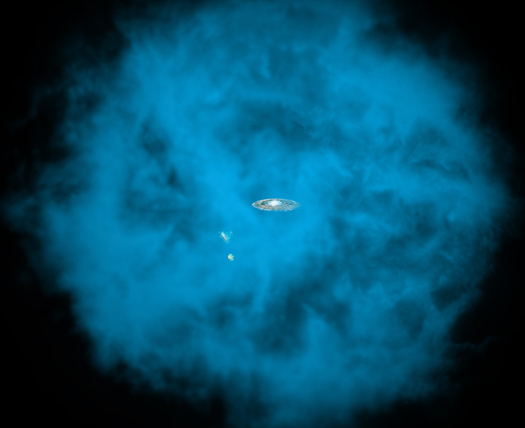
This artist's illustration shows an enormous halo of hot gas (in blue) around the Milky Way galaxy. Also shown, to the lower left of the Milky Way, are the Small and Large Magellanic Clouds, two small neighboring galaxies (roll your mouse over the image for labels). The halo of gas is shown with a radius of about 300,000 light years, although it may extend significantly further.
Submitted by chandra on Mon, 2012-07-30 17:33
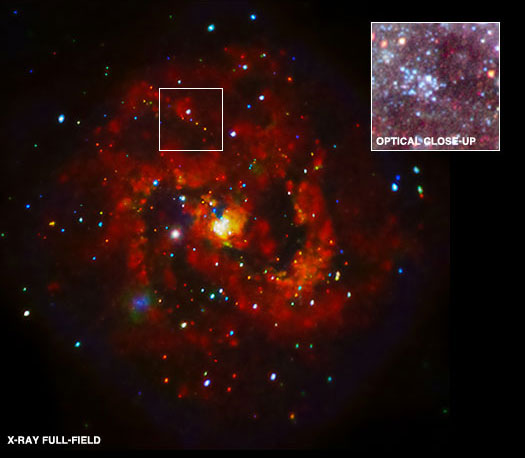
Over fifty years ago, a supernova was discovered in M83, a spiral galaxy about 15 million light years from Earth. Astronomers have used NASA's Chandra X-ray Observatory to make the first detection of X-rays emitted by the debris from this explosion.
Submitted by chandra on Thu, 2012-05-24 08:53

This image of the Pinwheel Galaxy, or also known as M101, combines data in the infrared, visible, ultraviolet and X-rays from four of NASA's space-based telescopes. This multi-spectral view shows that both young and old stars are evenly distributed along M101's tightly-wound spiral arms. Such composite images allow astronomers to see how features in one part of the spectrum match up with those seen in other parts. It is like seeing with a regular camera, an ultraviolet camera, night-vision goggles and X-ray vision, all at the same time.
Submitted by chandra on Wed, 2012-05-09 19:00
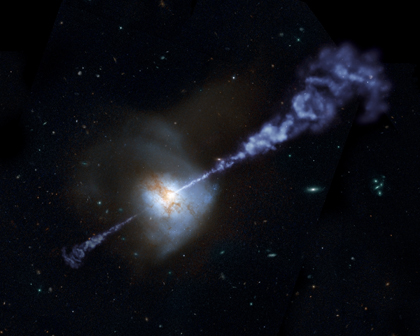
A new study has shown that galaxies with the most powerful, active, supermassive black holes at their cores produce fewer stars than galaxies with less active black holes. Researchers compared infrared readings from the Hershel Space Observatory with X-rays streaming from the active central black holes in a survey of 65 galaxies, measured by NASA's Chandra X-ray Observatory.
Submitted by chandra on Mon, 2012-04-30 10:32
William Blair is an astrophysicist and research professor at The Johns Hopkins University in Baltimore, Md. He penned this blog post to help explain the excitement -- and challenges -- involved with getting a handle on the mysterious ULX (ultraluminous X-ray source) he and his colleagues discovered in the spiral galaxy M83.
The spiral galaxy M83, also known as the Southern Pinwheel Galaxy, is an amazing gift of nature. At 15 million light years away, it is actually one of the closer galaxies (only 7-8 times more distant than the Andromeda galaxy), but it appears as almost exactly face-on, giving earthlings a fantastic view of its beautiful spiral arms and active star-forming nucleus. M83 has generated six observed supernovas since 1923, but the last one seen was in 1983. We are overdue for a new supernova!
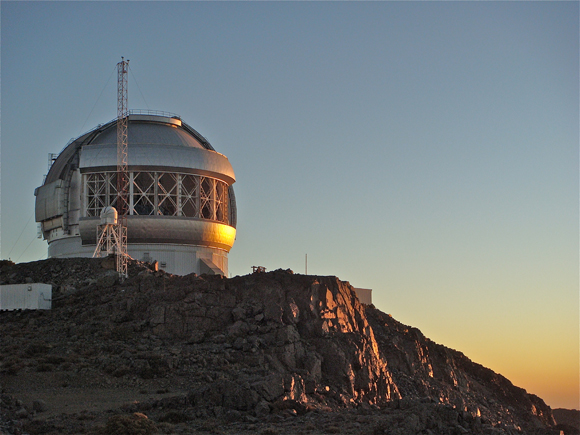 Gemini Observatory.
Gemini Observatory.Because of all the star formation and supernova activity in M83, we also expect there to be a lot of X-ray binary stars and supernova remnants—the expanding leftovers from old supernovas that stay visible for several tens of thousands of years after the supernova fades. By tying multiwavelength observations of M83 together, my colleagues and I hope to learn a lot about the interplay between the stars and the gas, and how they impact the entire galaxy.
Submitted by chandra on Wed, 2011-02-09 11:12
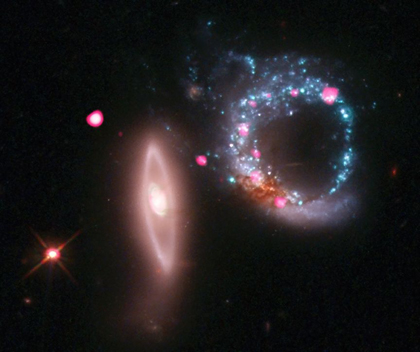
Just in time for Valentine's Day comes a new image of a ring -- not of jewels -- but of black holes. This composite image of Arp 147, a pair of interacting galaxies located about 430 million light years from Earth, shows X-rays from the NASA's Chandra X-ray Observatory (pink) and optical data from the Hubble Space Telescope (red, green, blue) produced by the Space Telescope Science Institute (STScI) in Baltimore, Md.
Arp 147 contains the remnant of a spiral galaxy (right) that collided with the elliptical galaxy on the left. This collision has produced an expanding wave of star formation that shows up as a blue ring containing in abundance of massive young stars. These stars race through their evolution in a few million years or less and explode as supernovas, leaving behind neutron stars and black holes.
Submitted by chandra on Thu, 2011-01-13 11:21
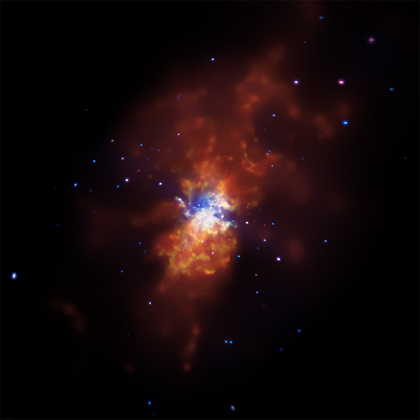
A new Chandra X-ray Observatory image of Messier 82, or M82, shows the result of star formation on overdrive. M82 is located about 12 million light years from Earth and is the nearest place to us where the conditions are similar to those when the Universe was much younger with lots of stars forming.
M82 is a so-called starburst galaxy, where stars are forming at rates that are tens or even hundreds of times higher than in a normal galaxy. The burst of star birth may be caused by a close encounter or collision with another galaxy, which sends shock waves rushing through the galaxy. In the case of M82, astronomers think that a brush with its neighbor galaxy M81 millions of years ago set off this torrent of star formation.
Submitted by chandra on Mon, 2011-01-10 09:31
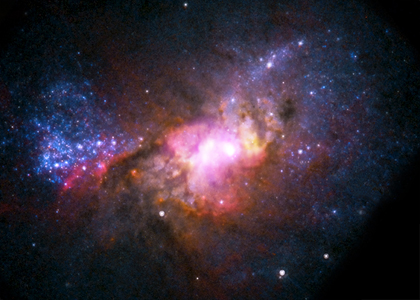
The combined observations from multiple telescopes of Henize 2-10, a dwarf starburst galaxy located about 30 million light years from Earth, has provided astronomers with a detailed new look at how galaxy and black hole formation may have occured in the early Universe. This image shows optical data from the Hubble Space Telescope in red, green and blue, X-ray data from NASA's Chandra X-ray Observatory in purple, and radio data from the National Radio Astronomy Observatory's Very Large Array in yellow. A compact X-ray source at the center of the galaxy coincides with a radio source, giving evidence for an actively growing supermassive black hole with a mass of about one million times that of the Sun.
http://www.chandra.harvard.edu/photo/2011/he210/
-Megan Watzke
Submitted by chandra on Thu, 2010-08-05 09:28
A beautiful new image of two colliding galaxies has been released by NASA's Great Observatories. The Antennae galaxies, located about 62 million light years from Earth, are shown in this composite image from the Chandra X-ray Observatory (blue), the Hubble Space Telescope (gold and brown), and the Spitzer Space Telescope (red). The Antennae galaxies take their name from the long antenna-like "arms," seen in wide-angle views of the system. These features were produced by tidal forces generated in the collision.
Pages